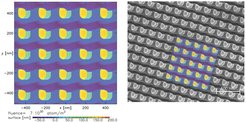Investigating physical sputtering on 3-D rough surfaces
Physical sputtering is the driver of several plasma-surface interaction processes such as magnetron sputtering, ion milling or analysis methods such as Sputter photoelectron spectroscopy (sputter-XPS) or Secondary ion mass spectrometry (SIMS). In addition, sputtering is the main physical process behind steady-state erosion of plasma-facing materials in nuclear fusion devices, and it has been the focus of extensive experimental and theoretical research in the past. Monte-Carlo codes such as SDTrimSP, which simulate sputtering by Coulomb interactions, have been successfully developed and benchmarked. However, these codes are incapable of simulating complex, 3-D rough surface morphologies.
Recently, the functionality of SDTrimSP has been expanded to model arbitrarily complex 3-D geometries. This code, dubbed SDTrimSP-3D, can now not only calculate physical quantities such as sputter yields or reflection coefficients as a function of the impinging particle fluence. It can also compute the evolution of the surface morphology and the elemental composition of the target during particle bombardment.
Experiments are carried out with the aim of benchmarking and further expanding the scope of the code. In these studies, custom samples with well-defined surface morphologies are eroded by particle bombardment, and the surface morphology and composition at various stages of erosion are checked with SDTrimSP-3D.

Right: Birds-eye view of Ta sample exposed to the same fluence, on which the modelled geometry has been overlaid, showing good agreement with the experimental data.
